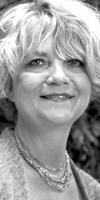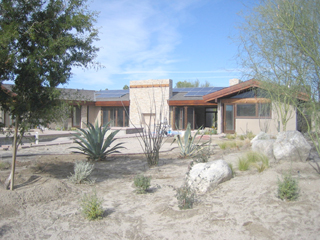
DJC.COM
February 19, 2009
LEED residential program encourages healthy homes
ZDS Architects and Firefly

Zahr Fleming
|

Pfitzenmeier
|
With LEED for Homes, architects have a standardized tool to serve people building single-family homes.
Homeowners can directly benefit from the attributes of a green dwelling. Open floor plans, cross ventilation, diffused natural lighting, renewable energy and efficient systems all work in concert with modern and green design.
Palm Springs home
For a Palm Springs, Calif., home designed by ZDS Architects to achieve a LEED-H silver rating, site strategies include the use of drought-tolerant plants, limited turf, shading for hardscapes, surface water management and nontoxic pest control. At least 40 percent of the site was left undisturbed during construction, and the designers followed a tree-preservation plan. The project is expected to finish this spring.

Photo by Suzanne Zahr Fleming Energy savings are expected to offset the cost of installing these residential solar panels within five to seven years. |
The home minimizes water use with an efficient irrigation system and high-efficiency plumbing fixtures, including a tankless water heater.
To decrease energy consumption, a solar panel system was installed, along with high-efficiency appliances and lighting.
The south-facing solar panels harvest renewable energy, helping the home achieve a net zero energy-use goal, in which the home harvests as much energy as it expends. Over five to seven years, electricity savings are expected to offset the cost of the building-integrated photovoltaics. (While this may not pencil out in the Pacific Northwest, other viable systems for our climate include geothermal heat.)
The home integrates measures to curtail heat loss and increase thermal efficiency. Windows and doors and thermal insulation are 35 percent more efficient than the California energy code requires. (California standards exceed Washington’s.)
| Palm Springs home |
|
ZDS Architects, Seattle General contractor: Hochanadel Construction, Palm Springs, Calif. Structural engineer: ABKJ, Seattle Mechanical engineer: Ecotope, Seattle Interior designer: Henderson | Kelly, Seattle LEED-H provider: Davis Energy Group, Davis, Calif. Landscape architect: Bennett Puterbaugh, Palm Springs, Calif. |
Thermal mass walls and floors are designed to absorb excess indoor heat during the hot desert days and release this stored heat during the cool desert nights, thereby reducing the temperature gradient. This exchange minimizes the amount of energy that the HVAC system expends to compensate for external temperature changes. Material-efficient framing uses structurally insulated panels that reduce the overall waste and increase the thermal efficiency of the building envelope.
The home’s environmentally friendly products were chosen based on three qualities: local production, sustainability or recyclable content, and low volatile-organic compounds emission.
Waste management diverts at least 25 percent of waste that would have otherwise been sent to a landfill.
Indoor environmental quality was maintained by installing a high-performance fireplace, high-end HVAC filers and timers on the bathroom exhaust fans. All the air ducts were sealed off during construction, and there’s a place to store shoes when people come inside. Finally, the home will be flushed continuously for 48 hours with the windows open before the owner moves in.
Life-cycle costs
Building green is less expensive when the life-cycle costs of the building are considered. The owners spend less on energy and water use, and save indirectly by way of better health and, in some cases, defrayed costs for environmental remediation.
Instead of asking what the cost of the home is initially, perhaps homeowners should ask what the true cost is, meaning the total over its life cycle.
Additional upfront expenses for a LEED-H home can vary depending on the design, goals and scope of work.
Early on, the design team can target specific strategies to control costs. Tax credits, rebates and grants can offset some initial costs. Renewable energy, efficient systems and resilient materials balance out upfront investments by reducing life-cycle costs.
Green gaining ground
The estimated share green home construction in the U.S. was 6 percent last year, compared with 2 percent in 2005.
The number of green homes constructed since 2005 is 332,900, with an average price of $296,000.
As of June last year, 10,250 new home projects have registered for LEED-H certification. While LEED is making an impact, out of 100 million homes in the U.S., between 2 percent and 10 percent are estimated to be green.
Some critics, including LEED-certified designers, maintain that the program is not effective enough, while research and data are lacking to substantiate its impacts.
By the U.S. Green Building Council’s own admission, the organization has been a victim of its own success and rapid growth. But its new version of LEED, planned for release this year, promises to deal with some of the pitfalls.
Reportedly, the new rating system introduces a 100-point scale that merges the past intuition-based allocation with new scientific analysis. As the most substantial LEED overhaul to date, it addresses carbon emissions and applies an environmental life-cycle assessment by assigning points based on environmental or human health.
Architects at ZDS find that working within the framework of LEED-H is simply good design, and results in healthy homes for their clients.
The owner of the Palm Springs home started out as a novice, unaware of the LEED program and its potential benefits. Motivated by ZDS’s offer to share some of the cost of the certification process, she became a steadfast convert with the first green home in her community.
When seen as a leadership and advocacy tool rather than a checklist, LEED for Homes can show design professionals how to learn more and educate others along the way, one home at a time.
Suzanne Zahr Fleming is an architect and founder of ZDS Architects in Seattle. Dyan Pfitzenmeier of Firefly is a writer and communication consultant.
Other Stories:
- Tenants can go green even if the landlord isn't
- Small measures can save big bucks during downturn
- Time to get serious about conserving energy
- How parking rules make cities less walkable
- Bog won’t sink this eco-friendly project
- Bank bailout has incentives for green building
- How Seattle can help green roofs to really grow
- Green school offers lessons on sustainability
- What owners need to know about LEED
- Want LEED credits for your lights? Plan early
Copyright ©2009 Seattle Daily Journal and DJC.COM.
Comments? Questions? Contact us.